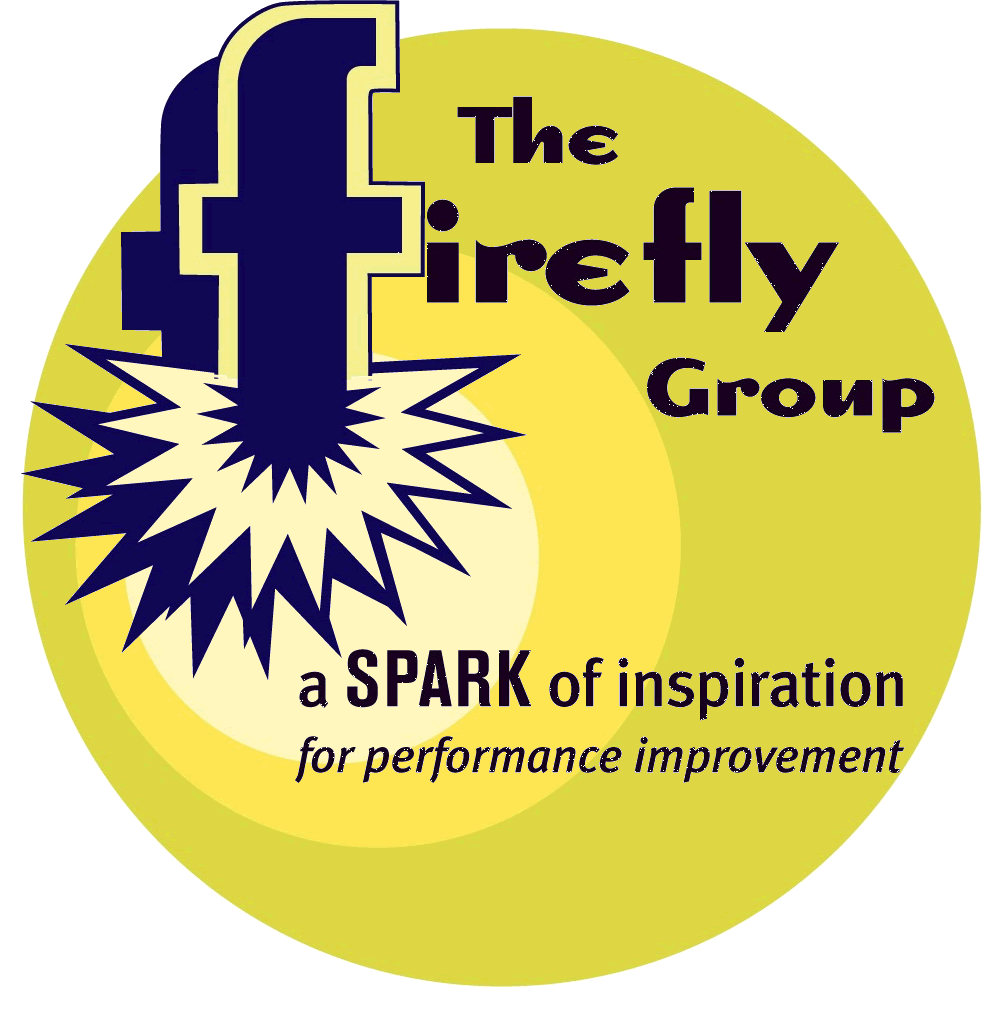

Of Note...
Brian Remer Receives Award for Lifetime Achievement. Read about it here:
What We Do
The Firefly Group helps people connect their every-day tasks with a bigger, wider sense of purpose and meaning. After working with Firefly, people are energized to attain the mission of their organization and they have a specific action plan to help them achieve their goals.
We do this through leadership development, performance improvement training, strategic planning, and clarification of organizational mission and vision. Our methods are engaging, thought-filled, and results-oriented.
If this sounds like a good direction for your organization, let's talk about how we might collaborate! Please give me a call (802.257.7247) or send an . - Brian
Where Can You Catch The Firefly Group?
Training
2012, Atlanta
February 13 - 15
"Say It Quick: 99 Words to Get to Performance Faster"
THE
Performance Improvement Conference (ISPI),
Toronto
April 20 - 23
"Performance
Improvement
in 99 Words"
ASTD,
Lincoln, NE
May 17
Keynote Presentation and Performance Improvement Workshop
North
American Simulation & Gaming Association (NASAGA),
Columbus
November 7 - 10
Keynote Presentation, Game Design Certificate Program Leader
|
|

Your ETR (Estimated
Time to Read): 5 minutes
Your ETII (Estimated Time to Implement Ideas): 5
weeks
February 2012
|
Say
It Quick |
Discoveries bits of serendipity to inspire and motivate |
Ideas fuel for your own continuous learning |
Activities tips and tricks you can try today |
| Crash Friendships | The Hormone of Love | Fight, Flight, or Friend? | Frame the Experience |
Is "love" an important element in successful teams? Inspired by Valentine's Day we'll explore this question beginning with this 99-Word Story.
Crash Friendships
I was zooming down the highway on the way to an appointment. I'd borrowed
my wife's car, a bright green VW Beetle. Coming toward me was the identical
car. In the brief moment as we passed, I could see the passengers smiling
and waving. We were friends in that instant!
Now this never happens when I drive my old Subaru! Yet people seem desperate to discover something in common. They'll grab the slimmest thread of shared interest and begin weaving a stronger relationship.
Perhaps we can use this strategy more often to create friendships, and build communities.
 The
Hormone of Love
The
Hormone of Love
It has been referred to as the "love" hormone because of its influence in
creating the bonds of attachment between mothers and their infants. But in
fact, oxytocin is at work any time we feel a connection to others no matter
what our relationship.
According to Wikipedia, many studies have shown a correlation between this hormone and human bonding, increases in trust, and decreases in fear. In a risky investment game, experimental subjects given nasally administered oxytocin displayed "the highest level of trust" twice as often as the control group. One explanation for this is that oxytocin might be inhibiting the amygdala which is believed to be responsible for our fear responses.
Most of us will probably never experience the effects of oxytocin as administered through a nasal spray. But we don't need to. We can feel its influence any time we see the smiling face of a loved one, get a hug, receive praise, shake someone's hand, express gratitude, offer assistance, or find something in common with a stranger. Even at 50 miles per hour, as the 99-Word Story relates, oxytocin can give our mood a boost.
Oxytocin does not necessarily override all our feelings of fear. According to research by Dr. Carsten K. W. De Dreu, a psychologist at the University of Amsterdam, as reported in the New York Times, the effects of Oxytocin induce feelings of loyalty to one's own group. "When people get together with others who share their values, that drives up the level of oxytocin," he said.
In The Myth of Choice, reviewed in the January News Flash, Kent Greenfield describes the many influences on our decision-making; not least of which is our brain chemistry. To say that our positive mood is a result of chemicals sloshing through our neocortex seems to put the regulation of our disposition out of our control. However, we can choose to change our mood. By making a conscious decision to reconnect to someone we care about, we can give ourselves a shot of oxytocin and become a bit less susceptible to the whims of our hormones - and our primal fears.
Perhaps the month of February is a good excuse to send plenty of Valentines - if only to give ourselves an oxytocin kick in the amygdala!
Fight, Flight,
or Friend?
If we can find friendships - or at least positive feelings of good will -
at 50 mph, there are probably many other situations when we would benefit
from a boost of oxytocin. What can we do in various situations to promote
attachment, commitment, and connection? This was the challenge raised by Allan
Silva, a keynote speaker at the most recent conference of the North
American Simulation and Gaming Association.
Silva, a professor of the Neuroscience of Leadership Development at Antioch University, talked about the well-known stages of group or team evolution put forth by Bruce Tuckman in 1965. Tuckman suggested that every group must go through the same four stages before it can function effectively. These stages include Forming, members are driven by a need to be accepted by each other; Storming, members express competing ideas that may be contentious; Norming, members agree upon goals and standards of behavior; and Performing, members function as a unit getting the job done smoothly and effectively.
But Silva has been researching the effects of oxytocin so he raised an interesting question. Do we have to endure the painful Storming stage in order to become effective team members in the Performing stage? After all, when we are angry, tense, or fearful, less blood flows to the neocortex while more blood flows to the limbic system. Rational thought gets hijacked by emotions. How effective can learning or collaboration be if we are overly stressed?
Humans have a hardwired response for either fight or flight when faced with extreme stress. But Silva noted that we also have a hardwired response for bonding and attachment and oxytocin is the key to that hardwiring. Why not capitalize upon that more positive attribute and spare everyone the difficulties of Storming by helping them connect with each other?
To counter Tuckman's model, Silva suggested four different stages for team formation: Framing, members set the stage for connections; Sharing, members solidify their connections by being somewhat vulnerable; Networking, members moderate or decrease anxiety; and Bonding, members establish strong connections of trust that lead to productive work. According to Silva, Storming in a group is a result of improper Framing.
When groups have their expectations "Framed" around connection and collaboration, they don't have to choose between fight or flight. They can "friend" instead.
Frame the
Experience
"I just know all you students are awesomely creative. This is going to be
a fantastic class!" Those were the words of my daughter's art teacher on the
first day of school.
"I don't know if she really means this or if she's using one of those techniques to psych us out!" Tilden said when she related this incident at home.
Either way, I figure this teacher is establishing a "Frame" for her students. It's likely that similar statements delivered sincerely will raise oxytocin levels in the students. The uncertainty and stress of the first few days will be reduced. The students will relax, they will learn more, their work will improve, and so on. This teacher is capitalizing on the hardwired ability for bonding, whether she realizes it or not.
Opportunities abound for increasing oxytocin levels and improving our work or learning environment:
This is a very short list of ideas that would work in the classroom, the boardroom, or the living room. Give one or more of them a try. Use the environment to model the connections you expect people to make with each other. Then please the experience you have framed!
|
If you like what you have read in this issue, I would like to bring the same innovation, creativity, and playfulness to your next meeting or learning event. Whether you need a keynote speaker, or help with strategic planning, performance improvement, or training facilitators and trainers in your organization, I look forward to your call (802.257.7247) or . -- Brian |
Read previous
issues. Click Library!
To add or delete your name to our mailing list, email
with a short note in the subject line.
I want this newsletter to be practical, succinct, and thoughtful. If you have suggestions about how I can meet these criteria, please let me know! Send me an with your thoughts and ideas.
Home
| Services
| Products
| Mission
| Ideas |
The Group
| The Buzz
(c)
2012 The Firefly Group